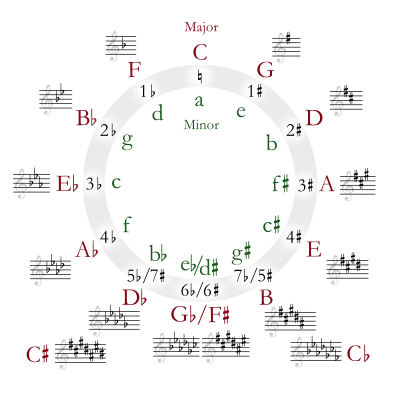E major
 | |
| Relative key | C♯ minor |
|---|---|
| Parallel key | E minor |
| Dominant key | B major |
| Subdominant | A major |
| Component pitches | |
| E, F♯, G♯, A, B, C♯, D♯, E | |
E major (or the key of E) is a major scale based on E, with the pitches E, F♯, G♯, A, B, C♯, and D♯. Its key signature has four sharps.
Its relative minor is C-sharp minor, and its parallel minor is E minor.
Only two of Haydn's 104 symphonies are in E major, No. 12 and No. 29. Even in the 19th Century, symphonies in this key were rare, with Bruckner's Symphony No. 7 being one of very few examples (see list of symphonies in E major). For Bruckner, "the key of E major is frequently associated with music of contemplation."[1]
Two symphonies that begin in D minor and end in E major are Havergal Brian's Gothic Symphony and Nielsen's Symphony No. 4.
 |
E major scale, ascending and descending
|
| Problems playing this file? See media help. | |
More typically, however, some symphonies that begin in E minor switch to E major for the finale, such as Sergei Rachmaninoff's Symphony No. 2, Peter Ilyich Tchaikovsky's Symphony No. 5 and Dmitri Shostakovich's Symphony No. 10. Starting with Ludwig van Beethoven's Piano Concerto No. 3, several works in the key of C minor began to have slow movements in E major, three examples of which are Johannes Brahms' First Symphony and Third Piano Quartet, and Sergei Rachmaninoff's Second Piano Concerto. Chopin's first Piano Concerto starts in E minor, but the last two movements are in E major.
Johann Sebastian Bach used E major for a violin concerto, as well as for his third partita for solo violin; the key is especially appropriate for the latter piece because its tonic (E) and subdominant (A) correspond to open strings on the violin, enhancing the tone color (and ease of playing) of the bariolage in the first movement. Felix Mendelssohn used E major for the finale of his well-known violin concerto, switching from a beginning in E minor, exploiting these advantages for the solo voice. Antonio Vivaldi used this key for the "Spring" concerto from The Four Seasons. Beethoven used the key of E major for two of his piano sonatas, Op. 14/1 and Op. 109.
Though E major is a very difficult key for many wind instruments, it is acceptable for orchestral strings, and quite suitable for the guitar. If available, clarinets in A should be used instead of clarinets in B-flat; the A clarinets would have parts written in G major, while the B-flats would have parts written in F-sharp or G-flat major.
Tan Dun used E-major as the foundation for his piece Internet Symphony No. 1. The piece changed to C major, then back to E major as it developed.
The bells of the Clock Tower in London's Palace of Westminster are tuned to the key of E major, with the result that the Westminster Quarters in their original setting employ the notes E, F-sharp, G-sharp, and B.
References
- ↑ Philip Barford, Bruckner Symphonies Seattle: University of Washington Press (1978): 52
See also
External links
 Media related to E major at Wikimedia Commons
Media related to E major at Wikimedia Commons
| Diatonic scales and keys | |||||||||||||||||||||||||||||||||||||||||||||||||||||||
|---|---|---|---|---|---|---|---|---|---|---|---|---|---|---|---|---|---|---|---|---|---|---|---|---|---|---|---|---|---|---|---|---|---|---|---|---|---|---|---|---|---|---|---|---|---|---|---|---|---|---|---|---|---|---|---|
 |
| ||||||||||||||||||||||||||||||||||||||||||||||||||||||
| The table indicates the number of sharps or flats in each scale. Minor scales are written in lower case. | |||||||||||||||||||||||||||||||||||||||||||||||||||||||